window VOLKSWAGEN GOLF 2009 Workshop Manual
[x] Cancel search | Manufacturer: VOLKSWAGEN, Model Year: 2009, Model line: GOLF, Model: VOLKSWAGEN GOLF 2009Pages: 516, PDF Size: 105.12 MB
Page 342 of 516
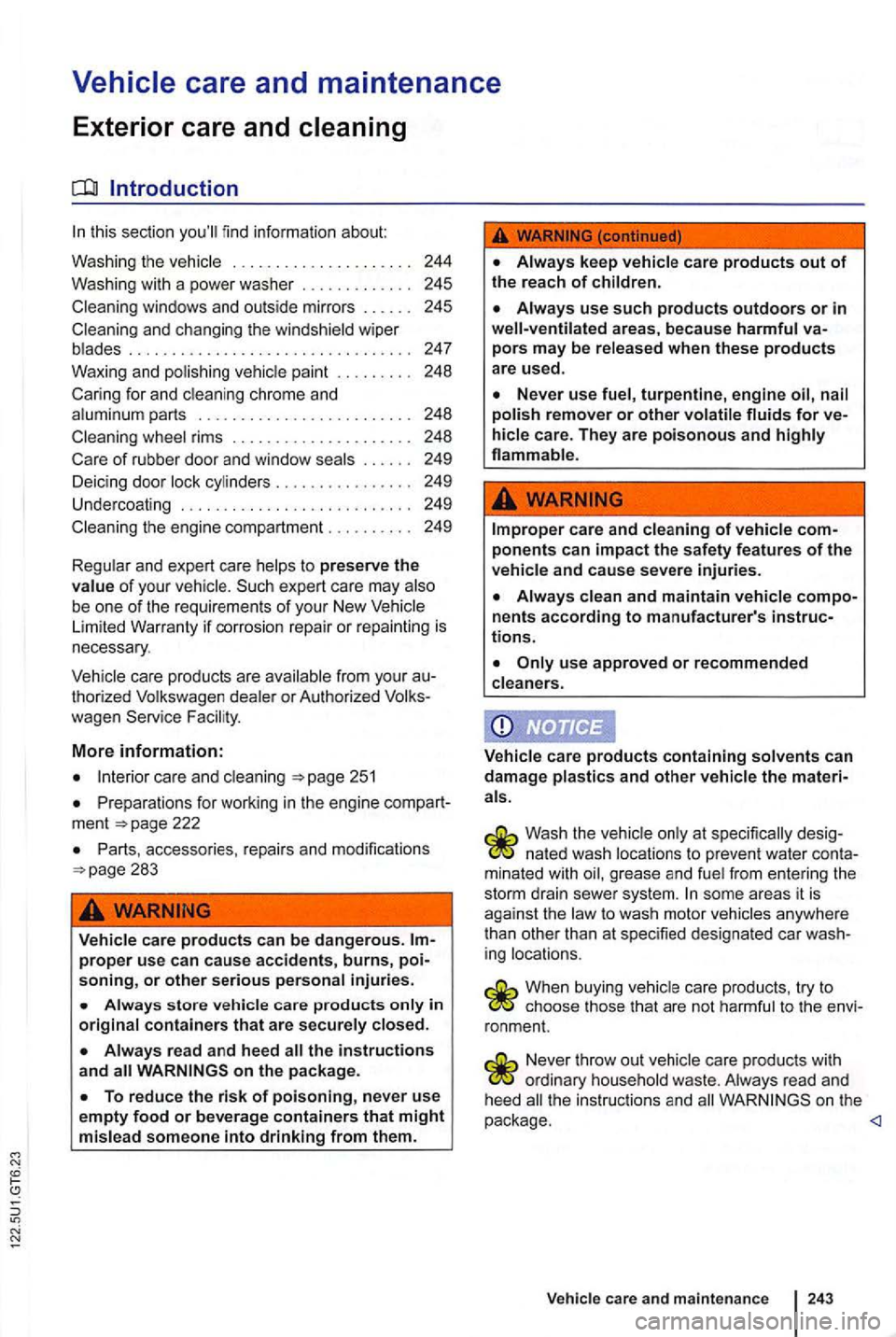
this se ction fin d i nfo rmation abo ut
Was hing the
244
Was hing with a power washer . . . . . . . . .
. . 245
Clea ning windows
and outs id e m irr ors . .
. . . . . 248
Caring for and cleani
ng chr ome and
a luminum parts . . . . . . . . . . . . . .
. . . . . . . . . . 248
Care
of rubber door and window seals . . . . . . 249
Deicing door . . . . . . . . . . . . . . . . 249
Undercoati ng . . . . . . . . . . . . . . . . . . . . . . . 249
C leani
ng the engine compartment . . . . . . . . . . 249
Regu la r
and expert care helps to preserve the value of your vehicle. Such expert care may
Limite d Warra nt y if corrosion repair or re pa int ing is necessary .
from your au
thorized Vol kswagen deale r or Authorized
More information:
ca re and clea ning
the instructions and
care products containing solvents can
damage plastics and other vehicle the materi
Wash the vehicle a t
fro m enteri ng the
storm drain sewer system. to was h motor
When buying vehic le care products , try to choose those that are not harmful to the envi
ro nment.
Never throw ou t ordinary household waste. Always read and
h eed the instructions and on the
package .
Vehicle care and maintenance 243
Page 343 of 516
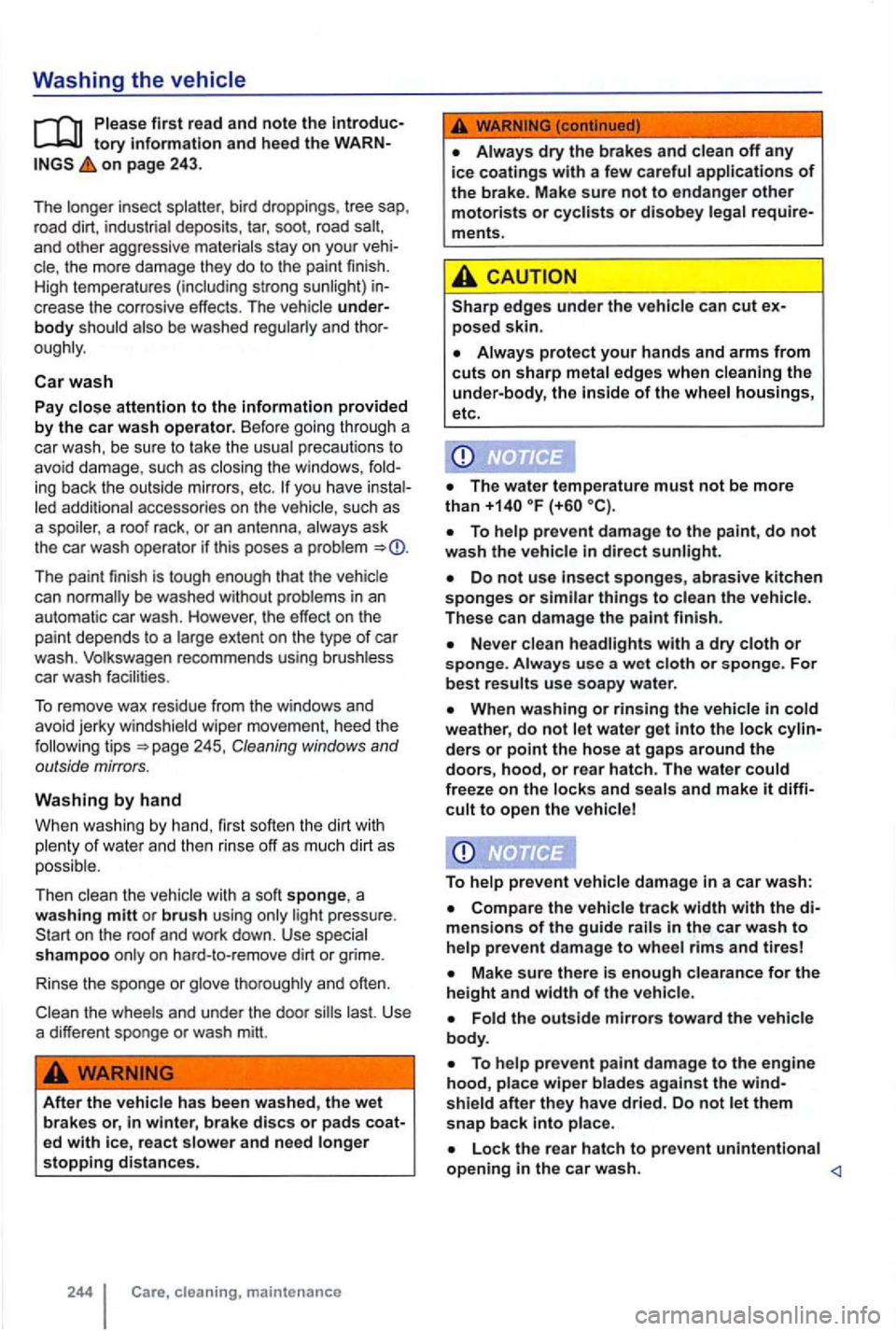
Washing the vehicle
tory information and heed the on page 243 .
T he longer insect splatter , bird droppings, tree sap,
r oad dirt , indust rial deposits , tar , soot , road
and othe r aggressive materials stay on your cle, the more damage they do to the paint finish.
H igh temperatures (includi ng strong sunlight)
oughly.
Car wash
Pay close attention to the information provided
by the car wash operator . B efo re goi ng throu gh a
ca r was h, b e s ure to take th e usual precautio ns t o
avoid damag e , such as closi ng the windows ,
The paint finish is toug h enough th at the vehicle can
the wheels and under the door
After the vehi cle ha s been washed , the wet brakes or, in winter, brake discs or pads ed with ice, react slower and need longer stopping distances .
WARNING
Always dry the brakes and clean off any ice coatings with a few careful applications of the brake . Make sure not to endanger other motorists or cyclists or disobey legal require-
ments .
edges under the vehicl e can cut ex-
posed skin.
Always protect your hands and arms from cuts on sharp metal edges when cleaning the under-body , the inside of the wheel housings,
etc.
The water temperature must not be more
than
Ne ver clean headlights with a dry cloth or sponge . Always use a w et cloth o r s ponge . For best result s use soapy water.
When washing or rinsing the vehicle in cold weather , do not
cult to open the vehicle!
To help prevent vehicle damage
in a car wash:
in the car wash to help prevent damage to wheel rims and tires!
Make sure there is enough clearance for the
height and width of the vehic le .
To help prevent paint damage to the engine
hood, place wiper blades against the shield after they have dried. Do not let them
snap back into place .
Lock the rear hatch to prevent unintentional
opening in the car wa sh .
Page 344 of 516
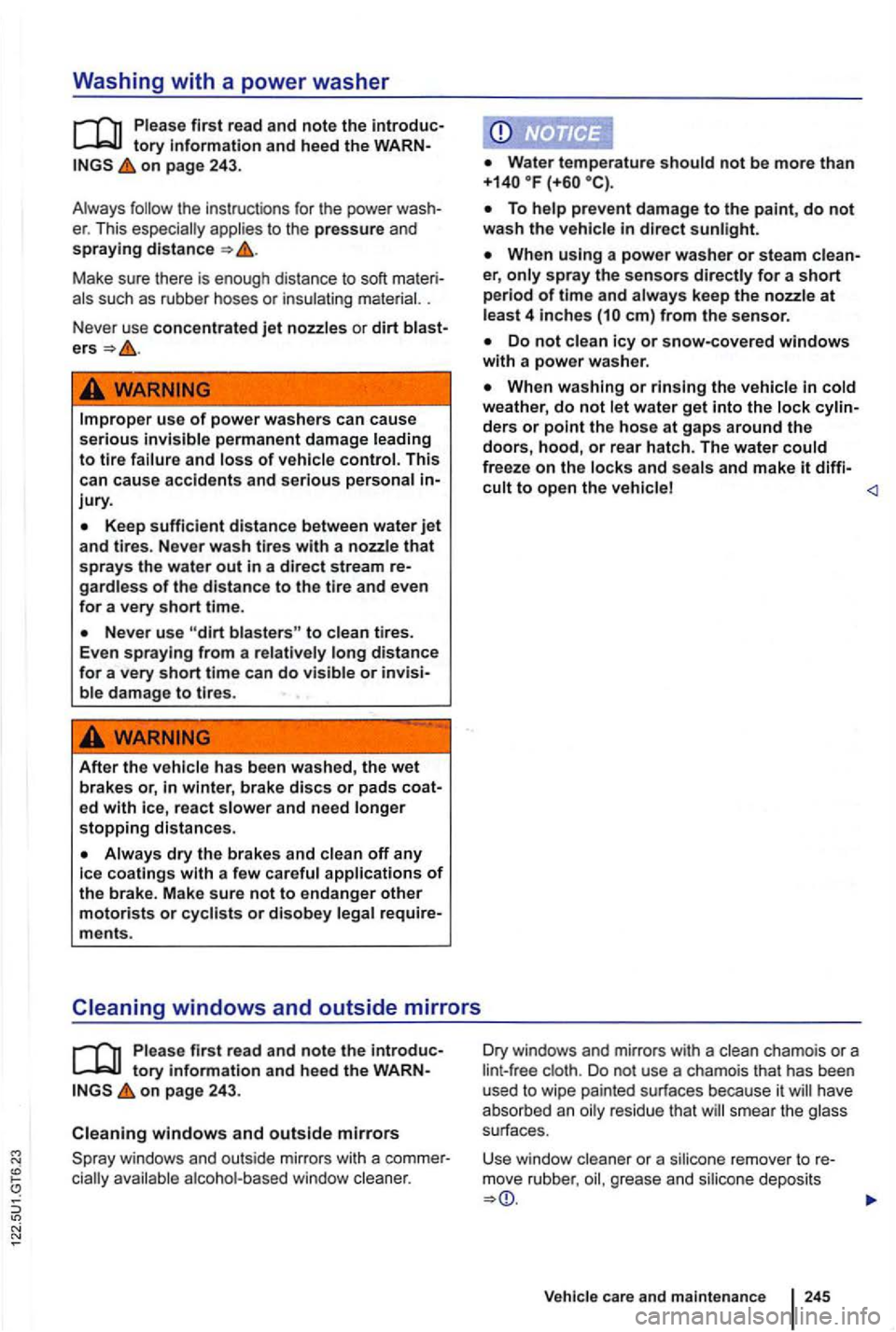
Washing with a power washer
tory information and heed the on page 243.
A lways
M ake sure th ere is e nough dista nc e to soft .
N ever u
se concentrated jet nozzles or dirt
use of power washers can cause serious invisible permanent damage leading to tire and loss of vehicle control. This can cause accidents and serious personal in-jury.
blasters" to clean tires .
Even spraying from a relatively long distance for a very short time can do visible or invisi-
After the vehicle has been washed, the wet brakes or, in winter, brake discs or pads coat-ed with react slower and need longer stopping distances.
Always dry the brake s and clean off any coatings with a few careful application s of the brake. Make sure not to endanger other motorists or cyclists or disobey require-ments.
P le a se first read and note the
on page 243 .
C lea
ning windows and outside mirrors
Water temperature should not be more than
To help prevent damage to the paint, do not wash the vehicle in direct sunlight.
When using a power washer or steam er, only spray the sensors directly for a short period of time and always keep the nozzle at least 4 inches em) from the sensor.
Do not clean icy or snow-covered windows with a power washer.
hav e
a bsorbe d an oily resid ue t ha t sme ar th e glass
s u rfaces .
U
se w indow cleaner or a s ilicone remover to mov e r ubbe r, oil, grease and silico ne dep osits
care and maint enanc e 245
Page 345 of 516
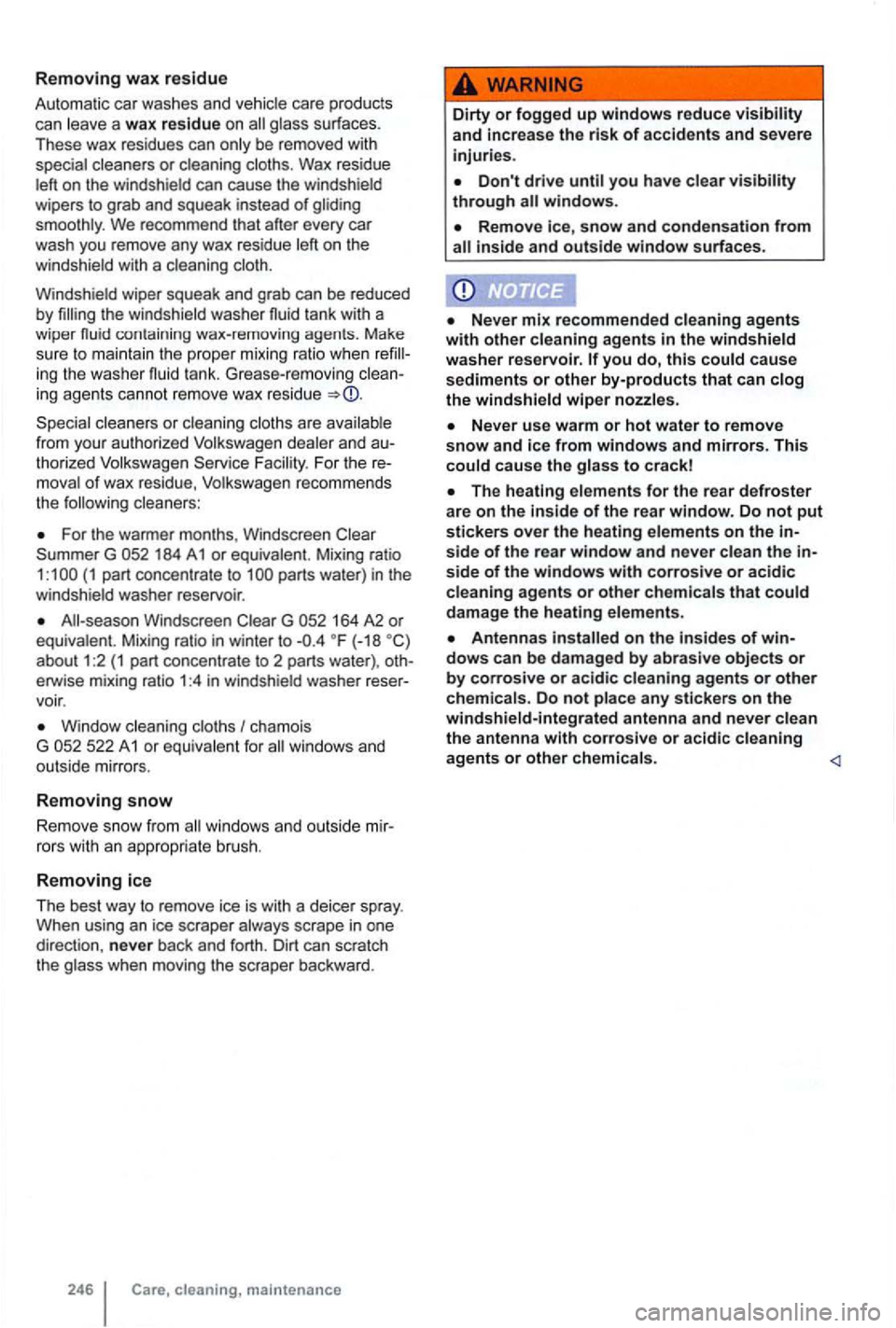
Removing wax residue
Automatic car washes and vehicle care products
can leave a wax residue on glass surfaces.
T hese wax residues can only be removed with
special cleane rs or clean ing clo ths. Wax residue
left on the wind shie ld can cause the windshield
wipe rs to grab and squeak instead
of
cloth.
Windshie ld wiper squeak and grab can be
reduced
by the winds hield washer fluid tank with a
wiper
fr om yo ur auth orized Volkswagen dealer and au
thorized Volkswagen For the re
moval of wax residue, Volkswagen recom mends
the cleaners:
For the warmer months, Windscreen Clear 184 A 1 or equivalent . Mixing ra tio (1 part concentra te to
(-18 about 1:2 (1 part conce ntrat e to 2 parts water) , oth
erwise mixing ra tio 1 :4 in windshie ld washer reser
voir .
Window cleaning cloths I ch amois
G 522 A 1 or equ iva le nt for windows an d
outside mirrors.
Removing snow
Rem ove snow from windows and outside mir
rors with an appropria te br ush .
Removing ice
Th e best way to remov e ice is wi
th a deice r sp ray. When using an ice scraper always scrap e in on e
direct ion , never bac k and forth . D irt can scratch
the glass when moving t he sc ra per backward .
WARNING
Dirty or fogged up windows re duce visibility and incre ase the risk of accidents and seve re
injuries .
Don't drive until you have clear visibility th rough all windows.
Never mix recommend ed cleaning agents
with other cleaning agents in the windshield
washer
Never use warm or hot water to remove snow and ice from windows and mirrors. This could cause the gla ss to crackl
The heating elements for the rear defroster are on the inside of the rear window. Do not put stickers over the heating elements on the inside of the rear window and never clean the inside of the windows with corrosive or acidic cleaning agents or other chemic als that could damage the heating element s.
Antenna s installed on the insides of windows can be damaged by abra sive objects or by corrosive or acidic cleaning agents or other chemicals . Do not place any stickers on the windshield-integrated antenna and never clean
the antenna with corrosive or acidic cleaning
agents or other ch emicals.
Page 346 of 516
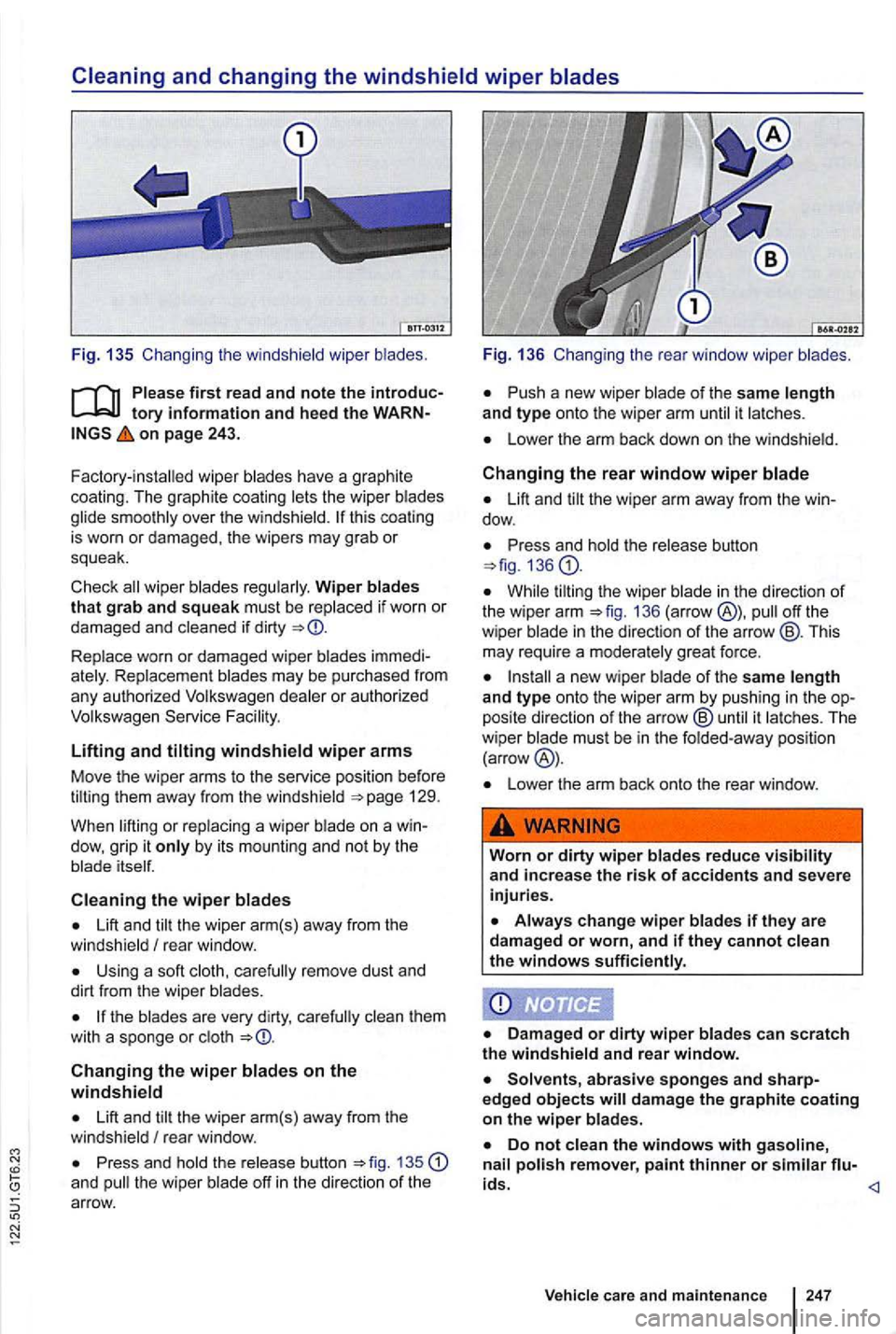
on page 243.
F ac tory
-installed wiper blades have a graphite
coating. The graphite coating lets the wiper blades
glide smoothly over the windshield.
wiper blades regularly. Wiper blades
that grab and squeak must be r ep laced if worn or
damaged and cleaned if dirty
Replace worn or damaged wiper blades immedi
ate ly . Replacement blades may be purchased from
any authorized Volkswagen dealer or autho
rized
Volkswagen
Lifting and
Us ing a soft remove dust and
dirt from the wiper blades.
Changing the wiper on the windshield
Lift and tilt the wiper arm(s) away from the
windsh ield I rear window.
Press and hold the release button 135 and the wipe r blade off in th e direction of the arrow.
N
N
Fig . 136 Changi ng the rear window wipe r blades .
Push a new wiper blade of the same length
and type onto the wiper arm until it la tches.
Lower the arm back down on the windshield.
Changing the rear window wiper
Lift and
Pres s and hold the release button 136
While tilt in g the wiper blade in the direction of the wipe r arm 136 (arrow @),
abrasive sponges and sharpedged objects
Vehicle care and maintenance 247
Page 348 of 516
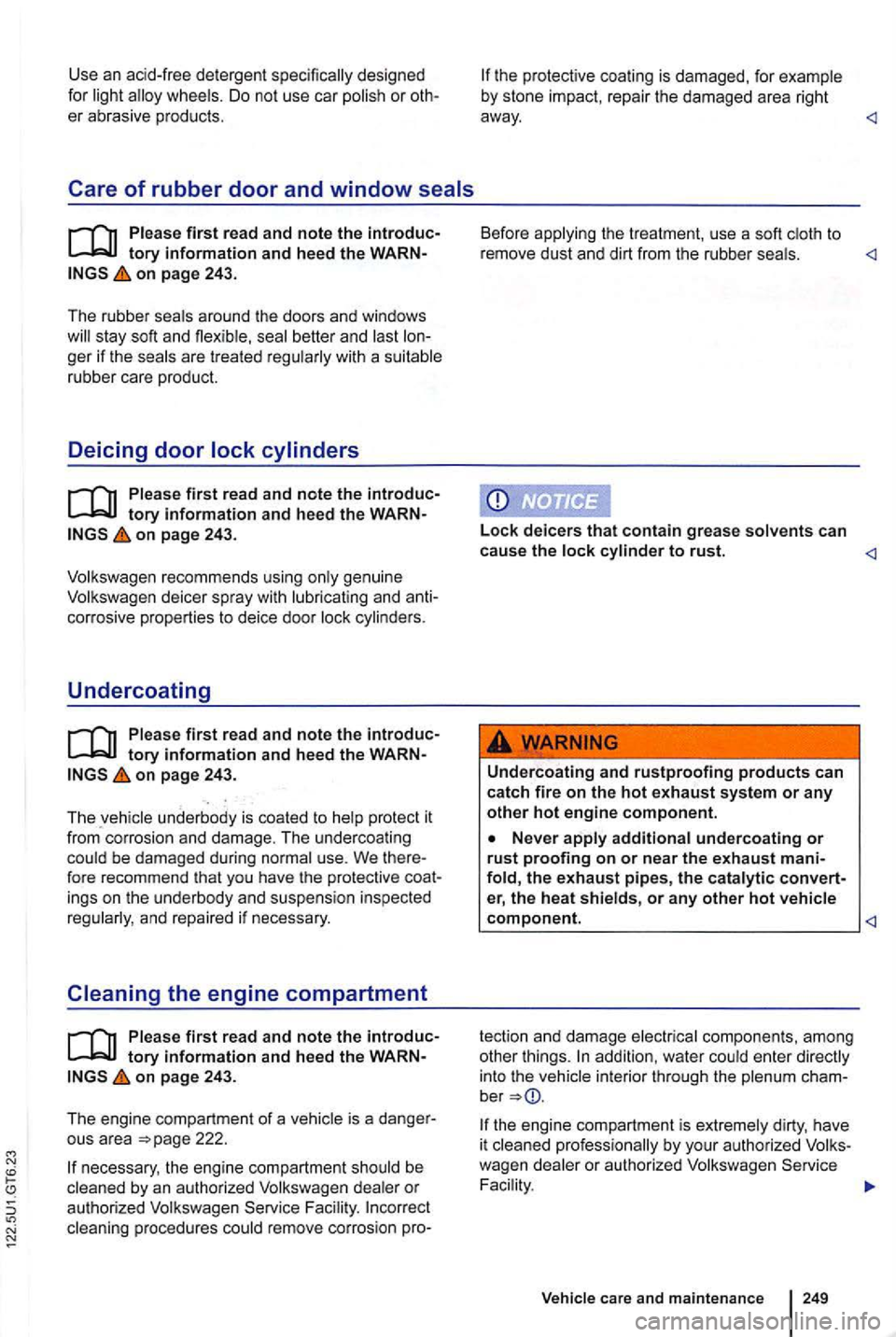
Use an acid-free detergent
page 243.
The rubber seals around the doors and windows
on page 243.
Volkswagen recommends using only ge nuine Volkswagen deicer spray with lubricating and anti
corrosive properties to deice door lock cylinders.
Undercoating
on page 243.
The vehicle underbody
is coated to help protect it
from " corrosion and damage . The undercoating
co uld be damaged during normal use. We there
fore recommend that you have the protective coat
ings on the underbody and suspension inspected
regularly , and repa ired if necessary .
Cleaning the engine compartment
on page 243.
The engine compartment of a vehicle is a danger
ous area
cleaning procedures could remove corrosion pro -
Before apply ing the treatment, use a soft to remove dust and dirt from the rubber seals.
Lock deicers that contain grease solvents can
cause the lock cylinder to rust.
Undercoating and ru stproofing products can catch fire on the hot exhaust system or any other hot engine component.
the exhaust pipes, the catalyti c converter, the heat shields, or any other hot vehic le component.
tection and damag e elec trica l components , among
other things. addition, water could enter directly
into the vehicle interior through the plenum cham
ber
Facility.
Vehicle care and maintenance 249
Page 391 of 516
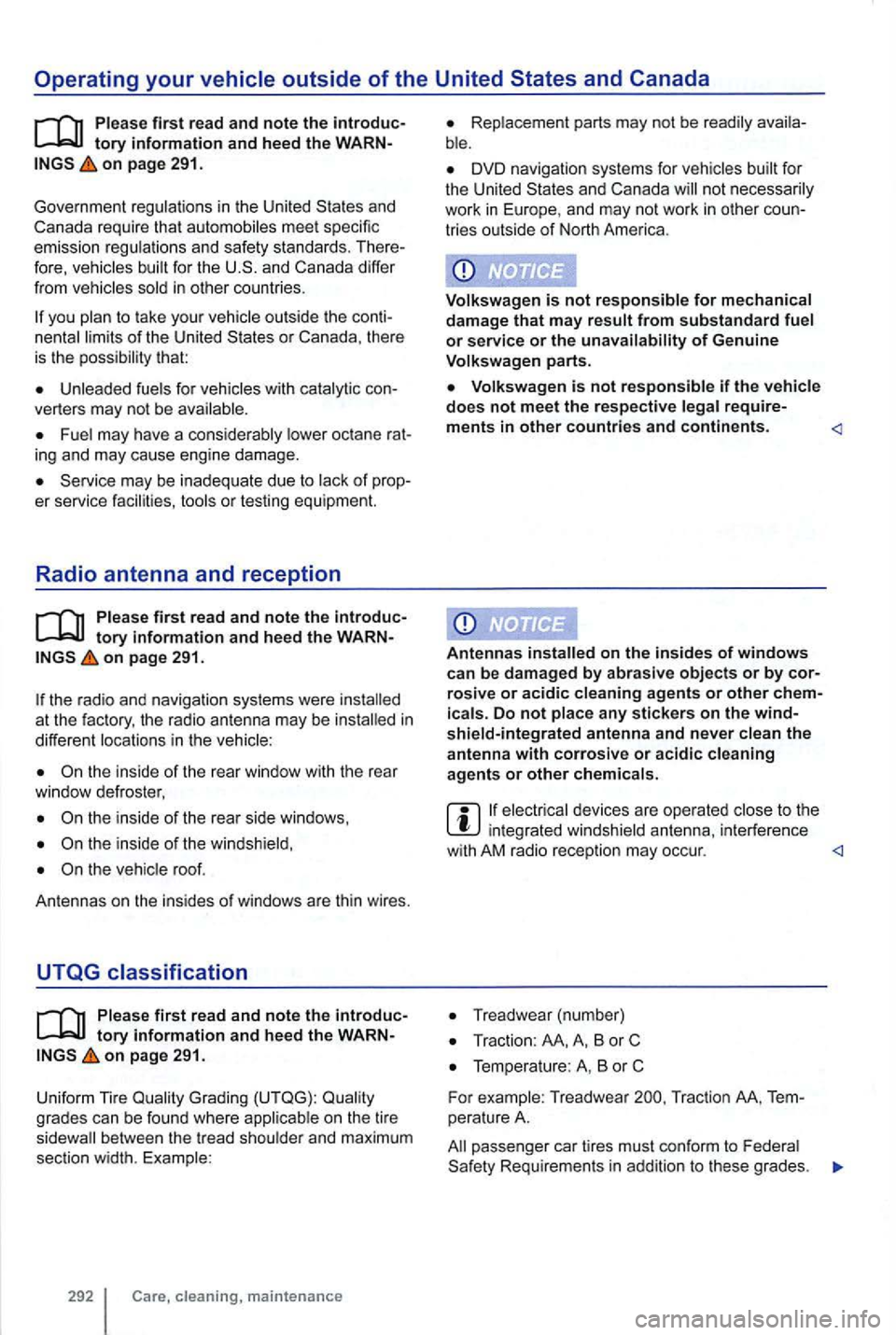
Operating your vehic le outside of the United
tory information and heed the on page 291.
Government regulations in the Unit
ed and Canada require that automobiles meet speci fic
emission regulations an d safely standards . for the and Canada differ
f rom vehicles sold in other coun tr ies.
to take your vehicle outside the or Canada , there is the possibility that:
Unl eaded for vehicles with catalytic
Fuel may have a co nsiderably lower octane ing and may cause engine damage.
may be inadequate due to
tory information and heed the on page 291.
the ra dio and navigation systems were installed
at the fac tory, the radio a ntenn a may be insta lled in differe nt locations in the vehic le:
the inside of th e rea r window w ith the rear
wi nd ow defroste r,
the inside of the rear side win dows,
the inside of the windshie ld ,
the vehic le roof.
An te nna s on the insides of windows are thin wires .
UTQG classification
on page 291.
Unif orm Tir e Quality Grading (UTQG) : Quality
grades can be found where applicab le on the tire
sidewa ll between the tread shou lder and maxim um
sec tion width . E xample :
Replaceme nt parts may not be read ily
DVD navigation systems for
tries outside of N orth Ame rica.
Volksw agen
is not responsible for mechanical
damage that may result from substandard fuel or service or the of Genuine
Volkswagen parts.
Volkswagen is not responsible if the does not meet the respective
icals. Do not place any stickers on the
agents or other ch emica ls.
to the integrated windshield antenn a, interference
w it h AM radio receptio n may occur .
Traction: AA, B or
Tempera ture : A , B or
Fo r example: Treadwear Tr ac tion AA, pera tur e A.
passenger car ti res must conform to Federal R equ iremen ts in add ition to these grades .
Page 426 of 516
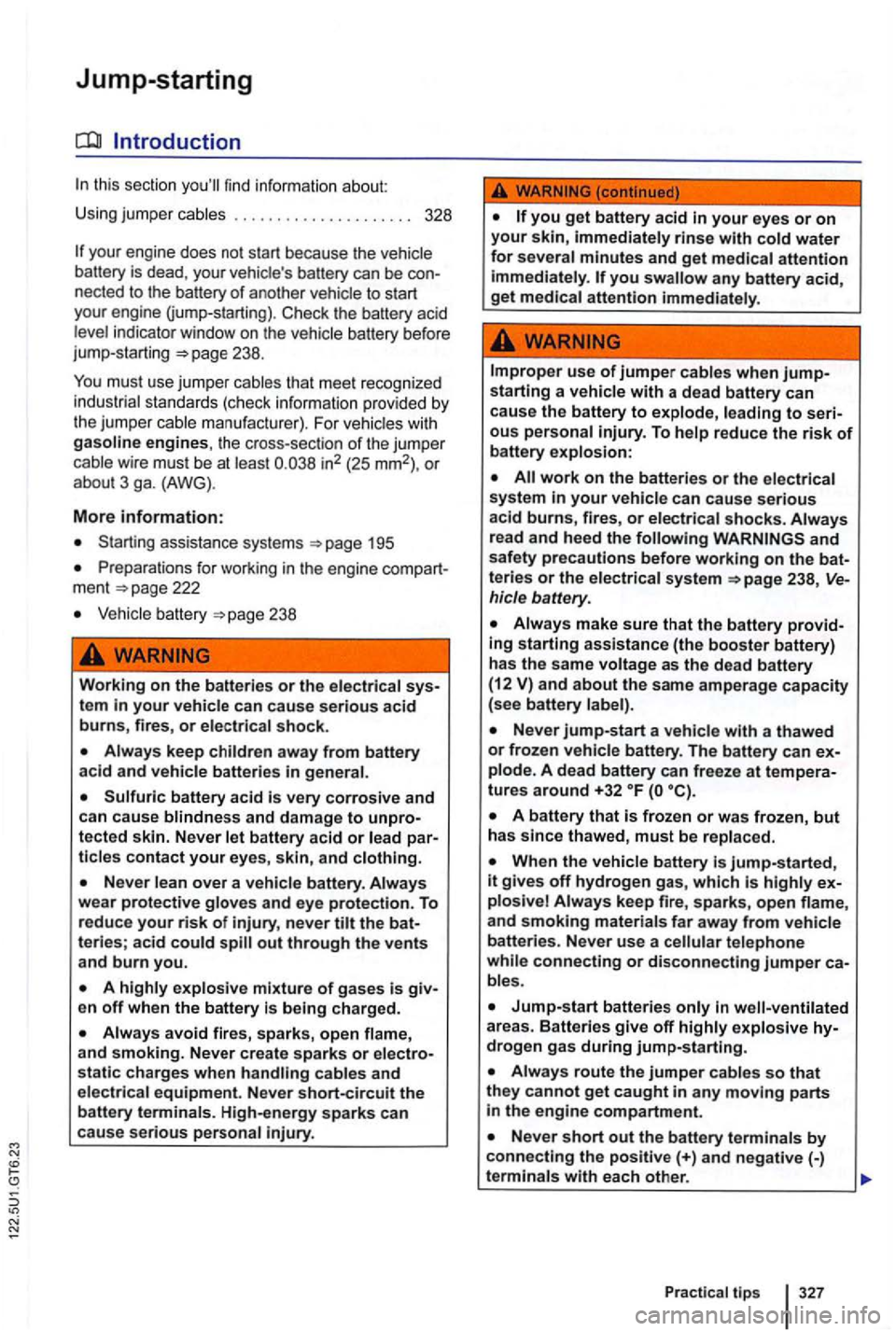
Jump-starting
this sect ion find inform atio n about:
U sing jum per cables . . . . . . . . . . . . . . . . . . . . . 328
your eng ine does not start because the
the battery acid
l evel indicator window on the vehicle battery before
jump -starting
with gasoline engines , the cross -sec tion of the jumper
cable wire must be at least
assistance systems 195
Prepara tions for worki ng i n the engine compa rt
ment 222
Vehicle battery
Working on the batterie s or the electrical syste m in your vehicle can cause serious acid burns, fires , or electrical shock.
Never lean over a vehicl e battery. Always
w ea r protective gloves and eye protection. To
r educe your risk o f injury, never tilt the bat
t e rie s; acid could spill out through the vents and burn you.
A highly explosive mixture of gases is give n off when the battery being charged.
you an y battery acid,
g et medical attention immediately .
work on the batterie s or the e lectrica l system in your vehicle can cause serious acid burns, fires, or electrical shocks. Always
read and heed the
Never jump-start a vehicle with a t hawed or frozen vehicle battery. The battery can explode. A d ead battery can freeze at tempera
tures around +32
A batt ery that is frozen or was frozen , but has since thawed, must be replaced.
Wh en the vehicle battery is jump-s ta rted ,
i t give s off hydrogen gas, which is highly ex
plosive! Always keep fire, s park s, open flame,
an d smoking mater ials far aw ay from vehicle batteries. Neve r use a telephon e while connecting or disconnecting jumper ca
bl es.
Practica l tips
Page 428 of 516
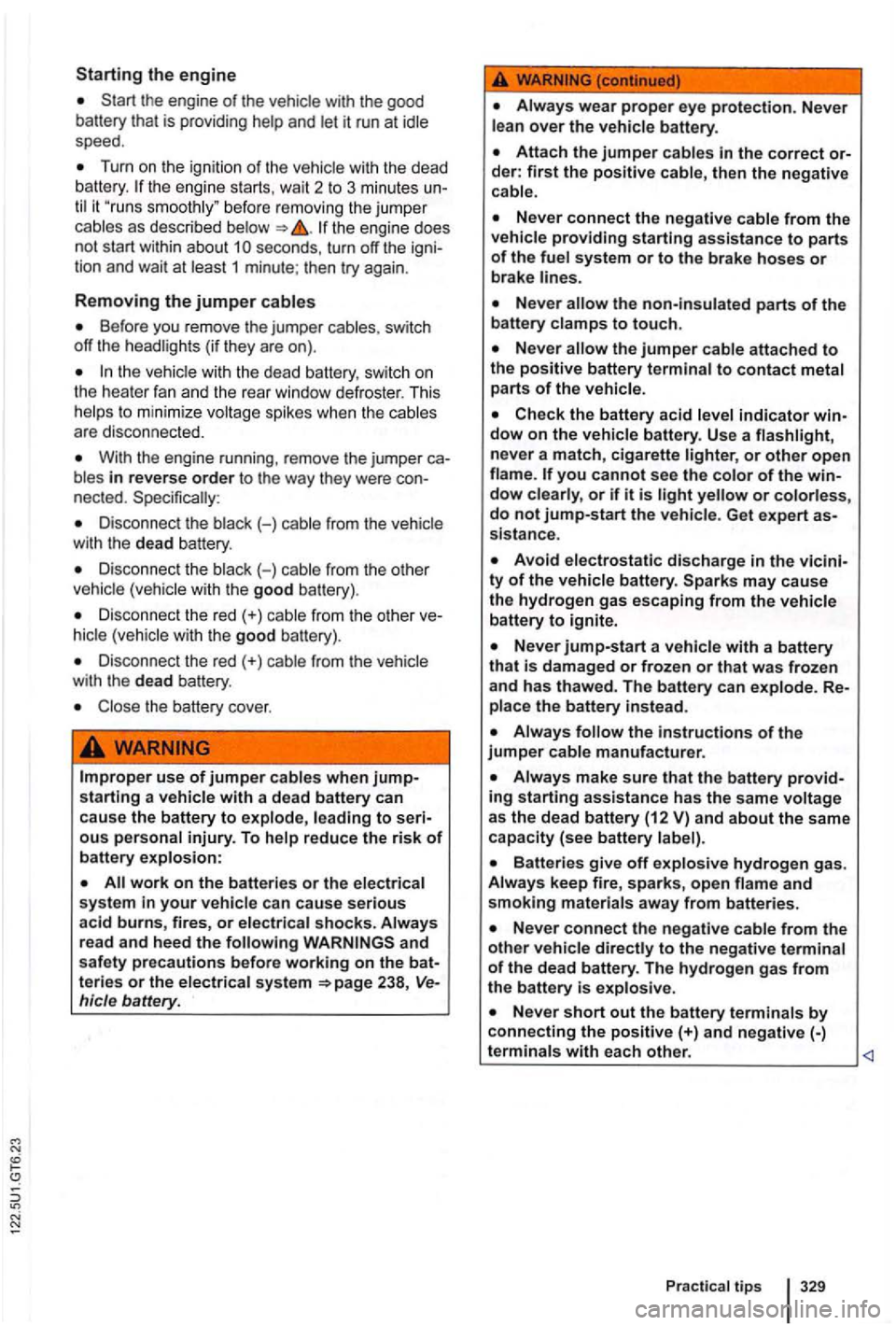
the engine
the engine of the vehicle with the good
battery that is providing help and let it run at idle
speed .
Turn on the ignition of the vehicle with the dead
b attery. the engine starts, wait 2 to 3 minutes
the engine does
not start within about seconds , turn off the tion and wait at least 1 minute ; then try again .
Removing the jumper cables
Before you remove the jumper cables. swi tch
off the headlights (if they are on) .
the vehic le with the dead batte ry , switc h on
t he heater fa n and the rea r window defroster. This
he lps
to m in im ize voltage spikes when the cables
a re disconnected.
With the engine running , remove the jumper
nected .
Disconnect the black (- ) cab le f rom the vehicle
wit h the dead battery .
Disconnec t the black (-) cable from the other
vehicle (vehicle with the good battery) .
Disconnect the red(+) cable from the other
Disconnect the red (+ ) cable from the vehicle
with the dead battery .
Close the battery cover.
Improper use of jumper cables when starting a vehicle with a dead battery can
cause the battery to explode , leading to
Always wear proper eye protection. Never
lean over the vehicle battery.
Attach the jumper cables in the correct
Never connect the negative cable from the
vehicle providing starting assistance to parts of the fuel system or to the brake hoses or brake lines.
Never
sistance.
Avoid electrostatic discharge in the may cause the hydrogen gas escaping from the vehicle battery to ignite.
Never jump-start a vehicle with a battery
that is damaged or frozen or that was frozen
and has thawed. The battery can explode.
Always the instructions of the jumper cable manufacturer.
Never connect the negati ve cable from the other vehicle directly to the negative terminal of the dead battery . The hydrogen gas from
the battery is explosive.
Never short out the battery terminals by connecting the positive(+) and negative
Practical tips 329
Page 438 of 516

safety seat . . . . . . . . . . . . . . . . . . . . . 103 the rear seat . . . . . . . . . . . . . . . . . . . . 109
seat
B ooster seat ........................ 114 Child seat mounting .................. 114 Co nvertible child sea t . . . . . . . . . . . . . . . . . 111 Infant carrier . . . . . . . . . . . . . . . . . . . . . . . . 110 Sec uring with loc ka bl e safety belt ....... 115 Securing with safety belt .............. 115
seats
Child seat mounting .............. 110, 111 Informati on about child restraint systems 121 Transpo rting children in vehicles . . . . . . . 107
veh ic le care . . . . . . . . . . . . . . . . . . . 243
Climatronlc
Also see: Air cond iti o ning . . . . . . . . . . . . . 207
............. ........•.......... 18 Sett ing t he time . . . . . . . . . . . . . . . . . . . . 2 8 Setting time . . . . . . . . . . . . . . . . . . . . . . . 18
Closing
Doors . . . . . . . . . . . . . . . . . . . . . . . .
. . . . . . . . 51 Windows .......................... 53 w ith Keyless Access . . . . . . . . . . . . . . . . 44 . . . . . . . 160
Cockp it ......................... ...... 9
. . . . . 28 1
Comfort turn . . . . . . . . . . . . . . . . . . . 123
Communication window . . . . . . . . . . . . . . . 128
Compact spare Drivin g style . . . . . . . . . . . . . . . . . . . . . . . 269
Front seats . . . . . . . . . . . . . . . . . . . . . . . . . 61
sunro of . . . . . . . . . . . . . . . . . . . . . . 57 win dows . . . . . . . . . . . . . . . . . . . . . 54
Engine coo la nt . . . . . . .
. . . . . . . . . . . . . . . . . . . . . . . . . . . . 125
Counter-steering assistance . . . . . . . . . . . 194
. . . . . . . . . . . . . . . . 197
weight . . . . . . . . . . . . . . . . . . . . . . . . . 140
D
Data recorded by control units . . . . . . . . . 287
Data recorded
(DRL) . . . . . . . . . . . 125
Daytime running (DRL) deactivation
DRL parking feat ure . . . . . . . . . . . . . . . . . 125
Daytime running lights (DRL) parking fea-
ture DRL deact i
vation . . . . . . . . . . . . . . . . . . 125
Declaration of compliance . . . . . . . . . . . . 294
. . . . . . . . . . . . . 293 Deicing door lock cylinders . . . . . . . . . . . . 249
Deicing locks . . . . . . . . . . . . . . . . . . . . . . . . 2 49
Department of Transportation uniform tire quality grades . . . . . . . . . . . . . . . . . . . . . . 292
Diagnosis . . . . . . . . . . . . . . . . . . . . . . . . . . . 297 Differential lock Br aking ass istance systems . . . . . . . 186
Digital clock . . . . . . . . . . . . . . . . . . . . . . . . . . 18 Dim en sions . . . . . . . . . . . . .
. . . . . . . . . . . . . 19
. . . . . . . . . . . . . . . . . . . . . . . . . . . 9
Doors ............................... 47 Child safe ty lock . . . . . . . . . . . . . . . . . . . . . 48 Emergency closing and ope ning . . . . . . . 301 Warnin g light . . . . . . . . . . . . . . . . . . . . . . . 47 Driver door Overview .....................•..... 9 Driving
Driving checklists and warning s . . . . . . . . . 31 Driving in other countries . . . . . . . . . . . . . . 32 Driving throug h wa te r on roads . . . . . . . . 33 Efficiency . . . . . . . . . . . . . . . . . . . . . . . . . 189 Environmen tally . . . . . . . . . . . . . . 189 gauge . . . . . . . . . . . . . . . . . . . . . . . . 21 5 too . . . . . . . . . . . . . . . . . 216 Getting ready . . . . . . . . . . . . . . . . . . . . . . . 31 on a dow nhill grade . . . . . . . . . . . 183 on an